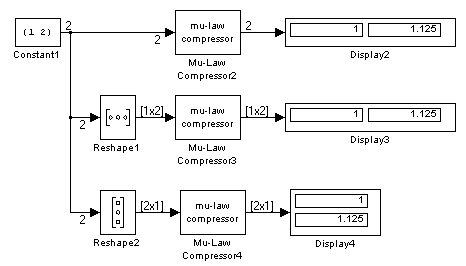| Communications Blockset |
  |
Processing Matrices, Vectors, and Scalars
These rules indicate the shapes of sample-based signals that Communications Blockset blocks can process:
- Most blocks do not process matrix signals that have more than one row and more than one column.
- In their numerical computations, blocks that process scalars do not distinguish between one-dimensional scalars and one-by-one matrices. If the block produces a scalar output from a scalar input, then the block preserves dimension.
- If a block can process sample-based vectors, then
- The numerical computations do not distinguish between one-dimensional arrays, M-by-1 matrices, and 1-by-N matrices.
- The block output preserves dimension and orientation.
- The block treats elements of the input vector as a collection that arises naturally from the block's operation (for example, a collection of symbols that jointly represent a codeword), or as samples from independent channels. The block does not assume that the elements of the input vector are successive samples from a single time series.
To find out whether a block processes scalar signals, vector signals, or both, refer to its entry in the reference section.
Illustrations of Scalar and Vector Processing
The figures below depict the preservation of dimension and orientation when a block processes scalars (without oversampling) and vectors. To display signal dimensions in your model, turn on the Signal dimensions option in the model window's Format menu.


 | Signal Terminology | | Processing Frame-Based and Sample-Based Signals |  |





